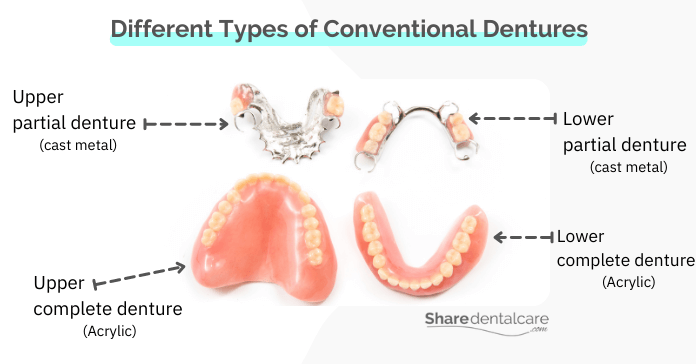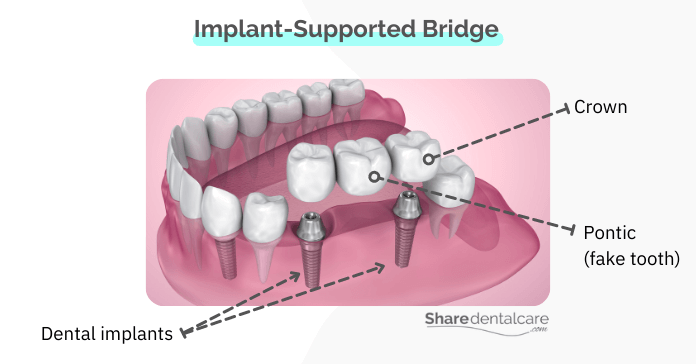It’s natural to lose a tooth or teeth. However, losing one or more can affect your smile, appearance, and self-esteem. Fake teeth for replacing missing teeth are an option you may want to consider. There are many types of fake teeth, such as dentures, bridges, and dental implants. They serve the same purpose of restoring your smile and making you feel more confident about yourself. Fake teeth offer a range of pros and cons, which we will discuss below.
What Are Dental Prostheses/Fake Teeth?
Dental prostheses, also known as fake teeth, are replacements for one or more missing teeth. Tooth loss can cause difficulty in chewing, speaking, & appearance issues. Getting a fake tooth can:
- Restore chewing function and your ability to speak clearly.
- Restore your smile.
- Hide the space from missing teeth for aesthetic reasons.
- Make you feel confident again.
- Improve your overall health because you will be eating better.

Types of Fake Teeth for Missing Teeth
All types of fake teeth can restore the function of your missing teeth. However, each type has its pros and cons, as listed below. Dental prostheses can be categorized into:
- Removable prostheses: are fake teeth that you can remove & clean, such as partial, complete, and implant-retained dentures.
- Fixed prostheses: fake teeth can’t be removed, such as traditional bridges and implant-supported bridges.
Conventional Dentures
Dentures are fake teeth attached to a gum-colored acrylic base to replace one or more missing teeth. They are categorized into complete and partial dentures. Complete dentures are suitable for adult patients with no teeth, while partial dentures replace a few teeth, for example, partial dentures for molars.
- Advantages: dentures are affordable in comparison with bridges and implants. They are easy to remove & clean.
- Disadvantages: dentures can’t be used with certain foods such as candies and sticky foods. They need to be taken out after eating for cleaning. Dentures can’t withstand high pressure, such as biting hard objects. They can slip around in the mouth. Dentures eventually have to be relined or replaced with a new set.

Traditional Bridges
Bridges are fixed fake teeth are attached to the adjacent teeth by crowns. The fake tooth bridge cannot be removed and therefore have more long-term value than dentures. There are different bridge types in dentistry, such as traditional, Maryland, and cantilever bridges.
- Advantages: bridges can be used with all foods without restrictions. They don’t need to be taken out after eating. They offer a more natural look than dentures. Dental bridges can last for 15 years or even a lifetime with proper care.
- Disadvantages: bridges are usually more expensive. They require the preparation of the adjacent teeth, which can cause damage to them.
Implant-Supported Prostheses
Dental implants are artificial tooth roots placed in your jawbone to act as anchors for fake teeth. Then, bridges or dentures are attached to these implants.
- Advantages: implants are aesthetic, durable, and can last a lifetime with proper care. No need for the preparation of adjacent teeth because they get support from the jaw bone. Also, implants prevent the loss of jawbone.
- Disadvantages: implants are more expensive than bridges and dentures. The placement of implants requires a surgical procedure and healing period, which can take three or more months.

Factors You Should Consider Before Choosing Fake Teeth for Missing Teeth
There are important factors you should consider before choosing dental prostheses, which are listed below:
- Cost: Dentures and bridges are more affordable while implants are the most expensive. Dental prostheses should not only be affordable but also long-lasting.
- Level of Chewing Function: Dentures do not restore chewing function properly. However, bridges & implants are great options to restore chewing function.
- Type of fake teeth: fake teeth can be fixed or removable. Learn more about the different types of teeth replacement.
- Number of Missing Teeth: Is it one tooth you lost or all the teeth in your jaw? The fake teeth option for replacing teeth should be decided accordingly. Read more about removable denture or fixed bridge for one missing tooth.
- Appearance: All the fake teeth options have different appearances, so they should be chosen considering your desire.
Talk to your dentist to know the treatment option that is best for you.
Fake Teeth for Missing Teeth – Conclusion
Fake teeth for replacing your missing teeth can restore your smile and confidence. There are many different available options. Dentures are affordable, and some options like bridges & implants can last a lifetime. The best fake tooth type is usually determined by cost vs. long-term use. So, we encourage you to speak with your dentist about which one is best suited for you.